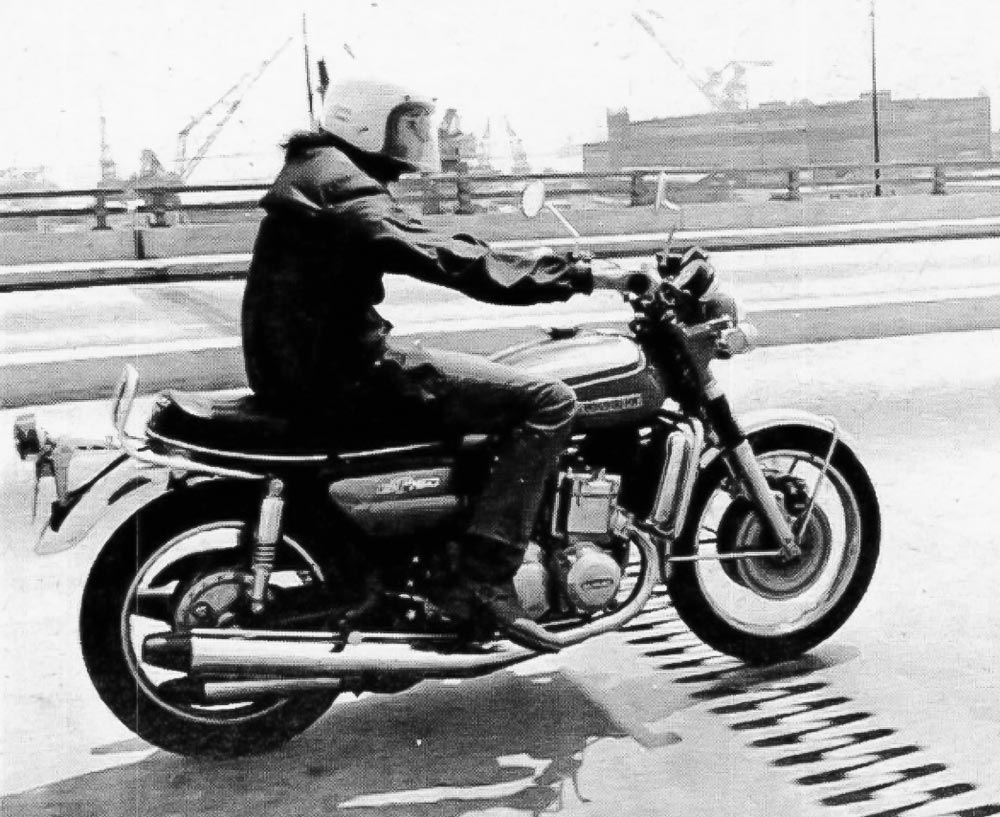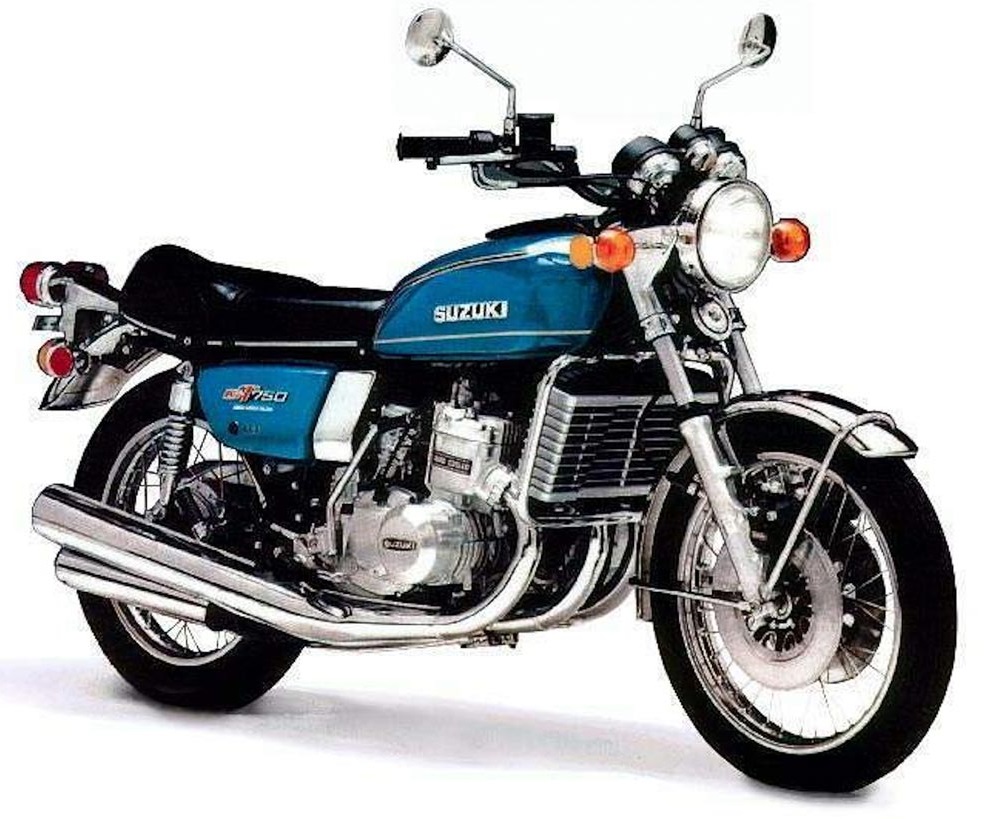| August 11, 2024
Cycle News Archives
COLUMN
Suzuki’s “Water Buffalo”
By Kent Taylor
Those motorcyclists who possess the kind of wisdom, maturity and sophistication that can be earned only after years of experience, i.e., old people, will undoubtedly remember the short-lived television series “Then Came Bronson.” Jim Bronson, the main character, has left the corporate world behind and spends a television season riding a Harley-Davidson Sportster, which was bequeathed to him by his late friend. In the show’s title sequence, Bronson, portrayed by Michael Parks, has pulled up alongside an all-business-looking fellow who is caged up in his family station wagon. As they sit at a red light, the suit and tie man asks the helmet-less Bronson if he is “taking a trip?” Bronson tells him that is exactly what he is doing, and when he adds that his destination is “wherever I end up,” the downhearted man wistfully says, “Man, I wish I was you.”
 Before the Gold Wing, there was the water-cooled 750cc two-stroke Suzuki GT 750. It made its debut in 1972. Cycle News tested the 1973 version.
Before the Gold Wing, there was the water-cooled 750cc two-stroke Suzuki GT 750. It made its debut in 1972. Cycle News tested the 1973 version.
Perhaps if our beaten-down businessman knew a little more about long-distance riding on motorcycles of that era, he might have been somewhat more content behind the wheel of his large automobile. While today’s riders can punch up a location on their smartphones and fully expect their smooth and reliable machines to carry them safely along the route, 1970s riders were slightly less confident of their steeds. Manufacturers who labeled their models as “touring motorcycles” were assuming plenty about both the reliability and suitability of their products to complete a long-distance ride in good stead.
One such labeled machine was Suzuki’s GT 750, which was released to the public, pretty in pink, in 1972. The Cycle News team tested that bike and then reviewed a mildly revised version in its September 18, 1973 issue. Before the big (750cc was considered big in 1973) bike had even warmed up, the CN crew expressed their doubts about the Suzuki.
“Somehow, a 750cc two-stroke seems like the wrong basis for a touring bike,” said the editor. What exactly was the right basis for a touring bike in 1973 is something that isn’t made very clear. Honda’s Gold Wing was two years away from its debut. Most other big bikes of that era, like Kawasaki’s Z1 900, were being marketed as performance machines, so why not the Suzuki?
The CN crew certainly gave the GT 750 many chances to fail this test, as they logged a rather staggering 2800 miles on the odometer. They found the two-stroke, three-cylinder engine to be torquey, with “ample low end.” At 6000 rpm, the big Suzy “gushes forth with a slight rush.” The staff felt the GT had enough power and mentioned that the bike “doesn’t need much downshifting to pass.”
Performance has a price, of course, and in this case, the GT-750 (metallic blue and white in its sophomore season) sent out its not-so-good vibrations to both itself and its pilot. By the end of the test, the motorcycle shook loose and pitched off both of its rear turn signals. Cycle News noted that “there is a little bit of vibration transmitted through the comfortable, swept-back handlebars” but suggested that the rider who was smart enough to wear “heavier gloves” would make “the problem disappear.”
The test bike was deemed mostly reliable by the staff, though it blew out a gasket in the crossover section of the exhaust, where three cylinders spread out into four pipes. This happened early in the test and made the bike “quite a bit nosier” for the next couple of thousand miles.
 The Suzuki GT 750, affectionately nicknamed “Water Buffalo,” was the first production water-cooled street bike.
The Suzuki GT 750, affectionately nicknamed “Water Buffalo,” was the first production water-cooled street bike.
The Suzuki featured a couple of “firsts” in the motorcycling world, with its liquid-cooling and dual disc brakes up front; both were making their first appearances in the world of mass-production motorcycles. The latter feature would leave the staff a bit perplexed, with some feeling that the brakes now worked “too well.” The notion of locking up the front wheel was disconcerting to some of the riders, but they added that “the Suzuki now stops,” indicating that the ’72 model was not so adept in this area.Puzzlingly, the writers weren’t satisfied with the GT-750’s straight-line skills, good (50 mpg) fuel mileage and strong pulling power. They wanted a canyon carver as well, and the ’72 model had let them down. They wanted “stuff it cornering” skills; Suzuki obliged by stiffening up the suspension on the ’73 model. Still, a lack of ground clearance and subpar rubber kept the staffer from scratching around the bends with this motorcycle.
It is truly hard to please everyone and so the CN review ends with something of a backhanded compliment to the “Water Buffalo,” a pudgy and plodding nickname with which the bike would eventually be branded. The staff generally liked the Suzuki but added that “a sports version of the GT-750 would be very exciting.”
Motorcycle manufacturers don’t take all of their cues from moto-journalists, however, and no such bike ever appeared. Four-stroke engines would soon reclaim the market for street bikes, and new touring motorcycles, like the aforementioned Gold Wing, set the benchmark for long-distance riders. The Water Buffalo roamed in Suzuki’s lineup for a few more good years before becoming extinct in 1977. CN